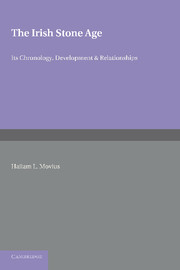Book contents
- Frontmatter
- Dedication
- Contents
- ILLUSTRATIONS
- FOREWORD
- PREFACE
- INTRODUCTION
- Part One THE CHRONOLOGY OF THE LATE-GLACIAL AND EARLY POST-GLACIAL PERIODS IN NORTHERN AND WESTERN EUROPE
- Part Two THE STONE AGE CULTURES OF IRELAND
- CHAPTER I The Antiquity of Man in Ireland
- CHAPTER II The Mesolithic Culture of the Irish Raised Beaches
- CHAPTER III The Origin and Affinities of the Larnian Culture
- CHAPTER IV Post-Larnian Developments
- CHAPTER V Conclusions
- Appendices I-VI
- REFERENCES CITED IN THE TEXT
- CLASSIFIED LIST OF REFERENCES TO CAVE RESEARCH AND STONE AGE ARCHAEOLOGY IN IRELAND
- ADDENDUM
- INDEX
CHAPTER IV - Post-Larnian Developments
from Part Two - THE STONE AGE CULTURES OF IRELAND
Published online by Cambridge University Press: 05 June 2016
- Frontmatter
- Dedication
- Contents
- ILLUSTRATIONS
- FOREWORD
- PREFACE
- INTRODUCTION
- Part One THE CHRONOLOGY OF THE LATE-GLACIAL AND EARLY POST-GLACIAL PERIODS IN NORTHERN AND WESTERN EUROPE
- Part Two THE STONE AGE CULTURES OF IRELAND
- CHAPTER I The Antiquity of Man in Ireland
- CHAPTER II The Mesolithic Culture of the Irish Raised Beaches
- CHAPTER III The Origin and Affinities of the Larnian Culture
- CHAPTER IV Post-Larnian Developments
- CHAPTER V Conclusions
- Appendices I-VI
- REFERENCES CITED IN THE TEXT
- CLASSIFIED LIST OF REFERENCES TO CAVE RESEARCH AND STONE AGE ARCHAEOLOGY IN IRELAND
- ADDENDUM
- INDEX
Summary
INTRODUCTION
The change in climate at the end of the warm moist Atlantic Period witnessed the arrival of two new influences in Ireland: one from the south-west by sea and the other from Northern France via Britain. The introduction of Megalithic culture into Ireland was the chief contribution from the southwestern source; from Northern France came an industry with definite Campignian affinities. As yet there is no evidence to prove which of these new influences reached Ireland first. Present data strongly suggest that they arrived more or less contemporaneously during the second half of the third millennium B.C. It should be made clear at the outset that it is not the writer's intention to examine in detail the question of the origin and development of the Megalithic culture which, as stated above, was the main south-western contribution. Whereas some of the megaliths in Ireland are admittedly Neolithic, the practice of constructing these monuments reached its peak with the first appearance of metal and is outside the scope of this book. Here it is proposed to consider only those Stone Age industries directly related to the Campignian of Southern Britain and Northern France, and to discuss the question of the continuity of Larnian tradition in Northern Ireland. In certain instances these were strongly influenced as a result of contact with the Megalithic complex from the south-west. Where this is found to be the case the nature of these influences will be examined.
The scope of this chapter as defined above presents certain difficulties. These arise from the fact that, in addition to the survival of indigenous Mesolithic (Larnian) tradition, the Campignian itself represents a basically Mesolithic heritage in the Western Neolithic complex, as indicated by Clark (1936, p. 160) and Mahr (1937, p. 402). In Britain and France the Campignian seems to be an industrial rather than a cultural manifestation of Western Neolithic culture, but as yet so few occupation sites of this period have been scientifically excavated in Ireland that it is difficult to cite any very convincing proof in this, regard. The bulk of the evidence is from axe factories, workshops and open surface stations which will be described below.
- Type
- Chapter
- Information
- The Irish Stone AgeIts Chronology, Development and Relationships, pp. 211 - 256Publisher: Cambridge University PressPrint publication year: 2013



